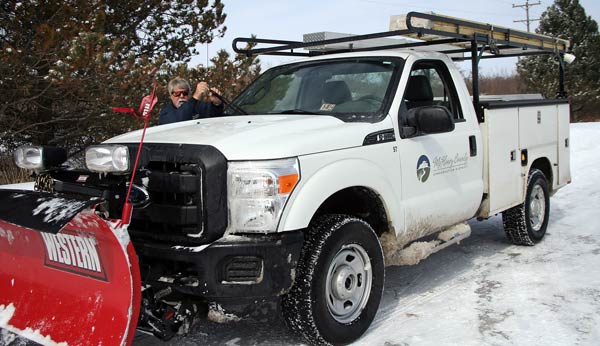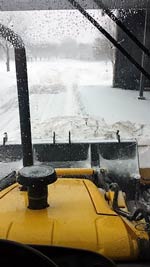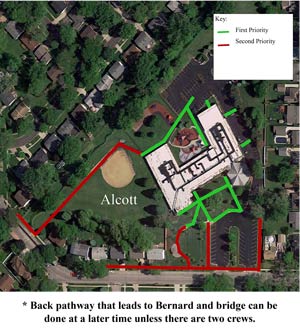
Winter Is ComingIt may not be the stuff of a hit series, but winter is coming for PDRMA members — and with it, concern about snowplow safety. PDRMA introduced a new snow plow driver training course this fall, and the three classes scheduled in November are already full. While these classes are comprehensive, and obviously popular, there’s still no substitute for an on-site training program.
McHenry County Conservation District (MCCD)
 Parks Supervisor Ben O’Dea and his crew operate with nine primary drivers, 10 trucks and one tractor, plus three alternate drivers who step in when the primary drivers are unavailable. (In the winter months, snowplowing is a 24/7 job.) The district launched formal training soon after it joined PDRMA. “We didn’t want ‘learn as you go’ on-the-job training,” he explains, pointing out that MCCD sends the entire snow plowing crew to the NIPSTA training PDRMA subsidizes every other year. “New operators learn proper snowplowing techniques, and it’s a refresher for our seasoned drivers,” he adds. “It reminds them about personal responsibility, job quality, workplace safety and customer satisfaction.” Parks Supervisor Ben O’Dea and his crew operate with nine primary drivers, 10 trucks and one tractor, plus three alternate drivers who step in when the primary drivers are unavailable. (In the winter months, snowplowing is a 24/7 job.) The district launched formal training soon after it joined PDRMA. “We didn’t want ‘learn as you go’ on-the-job training,” he explains, pointing out that MCCD sends the entire snow plowing crew to the NIPSTA training PDRMA subsidizes every other year. “New operators learn proper snowplowing techniques, and it’s a refresher for our seasoned drivers,” he adds. “It reminds them about personal responsibility, job quality, workplace safety and customer satisfaction.”
This comprehensive approach spans plowing patterns, snow removal techniques, pre-trip preparation and effective salting techniques. Training includes classroom instruction and hands-on driving exercises in the vehicles the employees will be operating all winter. “We also conduct annual in-house trainings and meetings about MCCD’s snow-removal specifics,” O’Dea notes. “Our goal is to avoid complacency.”
| October Is Fire Safety Month
There are two ways to fight a fire — after it starts or before it can happen. This year, PDRMA marks October as Fire Safety Month with its new fire safety training program, Fighting Fire Before it Starts: Facility Fire Prevention Inspection. Available Oct. 26 at Elk Grove Park District, Dec. 1 at Woodridge Park District and Feb. 15, 2018, at Glenview Park District, the program explores how to conduct an effective fire safety inspection. The combination of lecture, group activities and a facility walk through is a three-hour, 360-degree look at fighting fire before it starts. |
The training helps with the many complexities of a snow removal program, O’Dea points out. “From timely removal, careful plowing, clearing priorities, different surfaces, scheduling and monitoring the weather to proper ice melting agents, conditions for pre-treatment or salting, and the proper use of salting agents on surfaces and equipment, there are a variety of things to consider,” he says. “We send employees to the McHenry County Sensible Salting Workshop every other year. They learn application rates, weather conditions, levels of service, use of liquids, material storage, truck washing, new maintenance methods, environmental effects and state/local laws, plus National Pollutant Discharge Elimination System compliance and hands-on calibration with equipment. We want everyone to be prepared before the snow arrives.”
Buffalo Grove Park District
With a fleet of six snow plows plus riding blowers and other specialty equipment, two crews and nine buildings in different locations, Buffalo Grove Park District has been able to meet its annual snow-removal challenges — without injuries to employees or damage to property. According to Tim Beckmann, Buffalo Grove Park District Risk Manager, the agency’s maintained a record of no major claims for more than seven years. “We have a lot of staff who have been here for as long as 35 years, and we use a training process similar to a driver’s education class to benefit everyone.
“Our crew makes time for new operators to learn the process,” he explains. “Newer employees aren’t on a plow for a few years, because they need to learn different aspects over a longer period of time. Our operators instruct them about pre-inspections, how to back up safely in a busy parking lot, and how to interpret weather and lighting conditions. They go to an empty lot, and the new staffer sits next to an experienced driver and observes. Then they change seats, so the new staffer can practice plowing while the experienced one watches.”
It’s an on-going process at the agency. “We constantly educate each other and especially the younger workers,” Steve Houde, Grounds Foreman adds. “We review the safety aspects of plowing, including pedestrians, traffic and weather, and road conditions. It’s a constant process.”
 He notes that crews must also learn how different equipment operates and master the challenge of removing snow while people are using parking lots and sidewalks. “We noticed that where we pushed the snow could create an issue, so last year, we made a chart for each of our buildings indicating where to pile the snow and which sidewalk procedures to do first, so patrons and staff have a safe route from the parking lot to the building.” He notes that crews must also learn how different equipment operates and master the challenge of removing snow while people are using parking lots and sidewalks. “We noticed that where we pushed the snow could create an issue, so last year, we made a chart for each of our buildings indicating where to pile the snow and which sidewalk procedures to do first, so patrons and staff have a safe route from the parking lot to the building.”
Having a plan ready to implement as soon as the snow falls is essential. “Pre-planning is key,” says Randy Smith, Supervisor of Park Operations. “Be sure to define who is in charge when a big storm comes, since staff can be on call 24/7 during snow season. We also find it helpful to debrief at staff meetings and review pre-inspection procedures.”
No one can predict what winter might bring, but the key to safe and efficient snow removal is being prepared with well-maintained equipment and thorough training. Now’s the time to make sure your agency gets ready for what’s coming — before it arrives. |

